The 60-plus resident and guest exhibitors between them offer a round-the-world tour of indigenous cultural artworks from Australasia, Oceania and the Americas to Africa and Asia. Some are mixing a number of different cultures, others are focusing on one continent or holding thematic shows.
This is a very popular event from the standpoint of both exhibitors and clients. As Pierre Moos, director of the organisers explained, every year they turn down many prospective applicants and it is also important to have pieces at every price level to encourage new collectors alongside established ones.
Advance interest from tribal aficionados from France and much further afield was such that many dealers had reservations on their star prizes, always a pleasing situation for the exhibitors.
Pictured here is a selection of early sales, individual highlights and views of some of the exhibitor displays that can be found in the course of the stroll round the Parcours. The event continues until September 17.
1. Luba Hemba stool
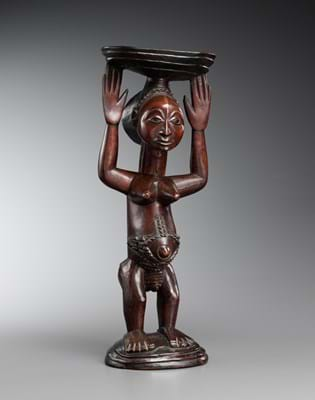
This rare carved Luba Hemba caryatid stool is one of the prize pieces which Bernard de Grunne from Belgium is showing at Galerie Patrice Trigano on the rue des Beaux-Arts. These carvings are important symbols of strength and power in the Luba and Hemba Kingdoms in the Eastern Democratic Republic of Congo. The stool which is priced in the region of €300,000-600,000 is displayed alongside two other examples loaned from private collections for comparative purposes and a detailed catalogue has been produced for the exhibition discussing on the evolution of these royal stools. Photo credit: Frédéric Dehaen
2. Luba bowl
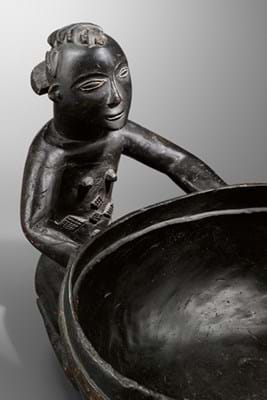
This rare Luba bowl from the Democratic Republic of Congo is one of the star pieces on show at Galerie Monbrison, one of the resident exhibitors at the ‘Parcours des Mondes’ based on the rue des Beaux-Arts. Dating from the late 19th or early 20th century and formerly owned by the dealer and tribal expert Charles Ratton, it is priced at €600,000. Photo credit: Vincent Girier Dufournier.
3. Asmat drum
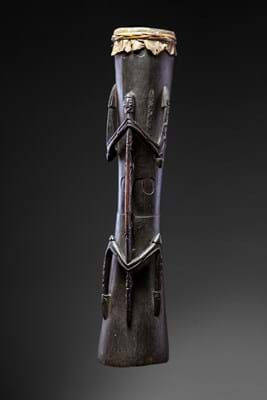
Michel Thieme from the Netherlands has put his emphasis on a selection of works from the Asmat peoples of Papua, Indonesia for his ‘Parcours des Mondes’ show on the rue des Beaux Arts. One of the Amsterdam dealer’s star exhibits is this rare 35in (88cm) high Asmat drum which is carved to the front with a figure of a praying mantis. The insect, whose female devours the male after mating, has a special significance in Asmat culture symbolising head-hunting. In 1954 the drum was given to Father Boelaars by the staff of the Agats diocese in recognition of his ethnographic research in the Asmat area. It is priced at €60,000. Photo credit Jan van Esch.
4. Michel Thieme’s display

A view of part of Michel Thieme’s display for the ‘Parcours des Mondes’ at Galerie Art is You on the rue des Beaux-Arts. The Amsterdam dealer is a regular exhibitor at the event and is one of two dealers from The Netherlands who are participating this year.
5. Maori fishhook
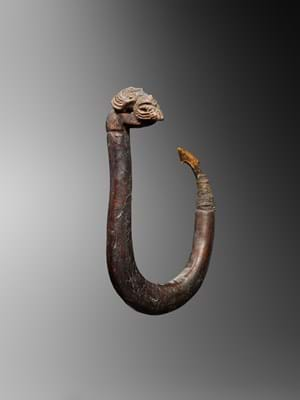
This rare 7in (17cm) high Maori fishhook from the 19th century or earlier made from carved wood, albatross bone and fibre, was an early sale at the ‘Parcours des Mondes’ for resident dealer Jean- Edouard Carlier of Voyageurs & Curieux specialising in Oceanic art on the rue Visconti. Photo credit: Hughes Duboi.
6. Galerie Eric Hertault

An interior view of the Galerie Eric Hertault showing his selection of African art. The resident dealer is exhibiting for the first time in his own gallery at the ‘Parcours des Mondes’ on the rue Visconti and has made a number of early sales.
7. South Seas war clubs
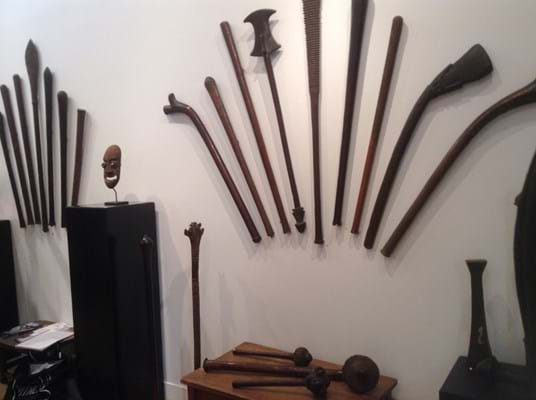
A view showing the display of ‘War clubs from the South Seas’ that Michael Evans from US has taken to the Parcours des Mondes. He is sharing a space with Farrow Fine Art, also from the US, at the Galerie Couteron on the rue Guénegaud. On opening day Evans had already sold five clubs.
8. Tridacna shell pendants
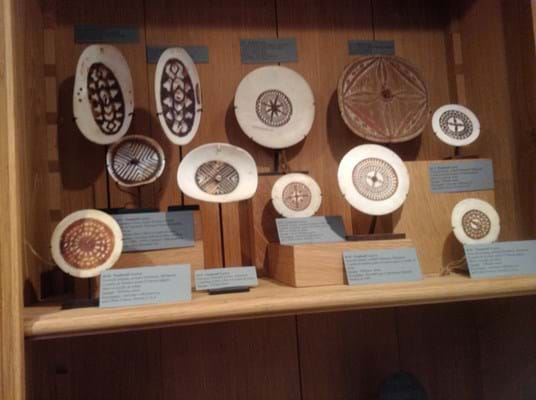
A view of a display of pendants from New Ireland made from tridacna shell at Voyageurs & Curieux during the ‘Parcours des Mondes’.





